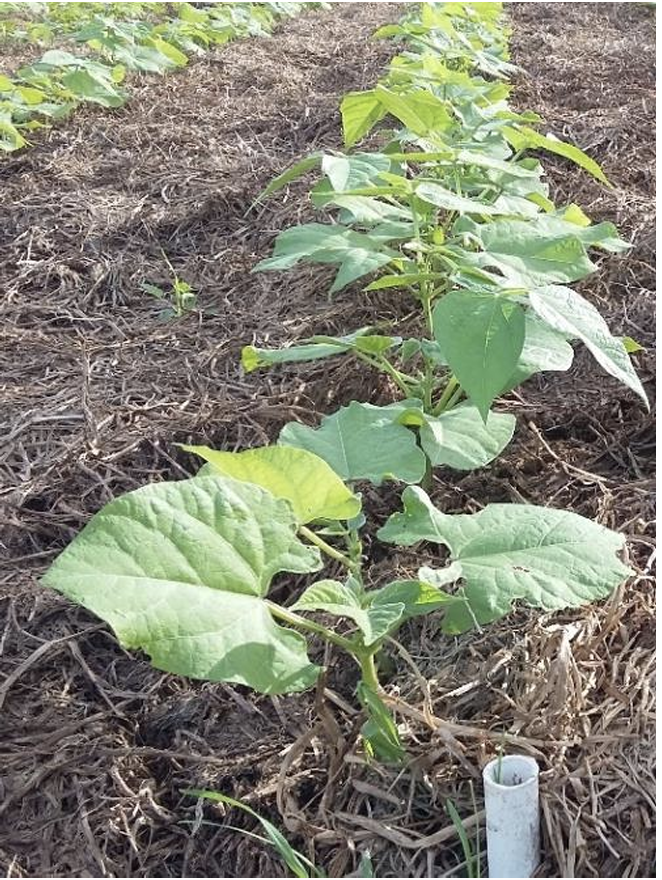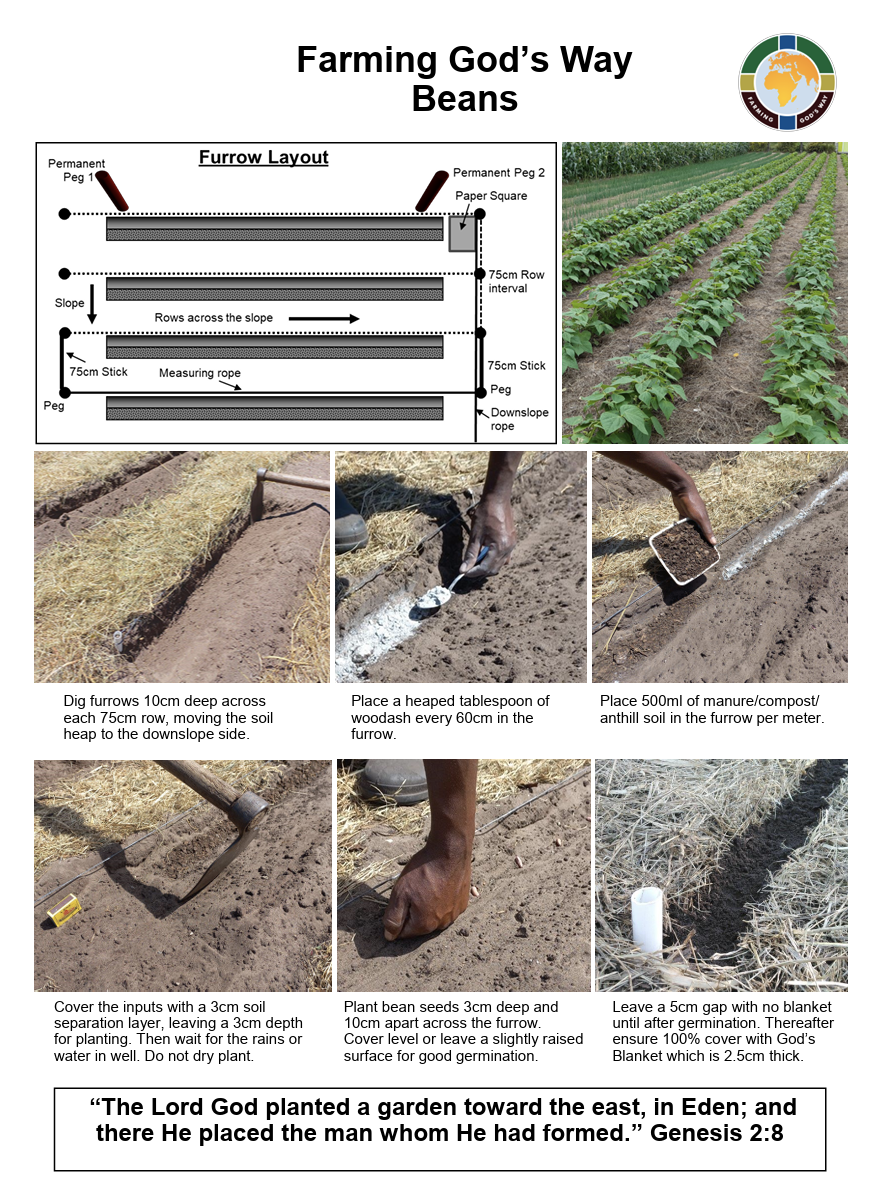A) Green Beans and Peas - Surface Composting Technique
Besides being high in protein, which is especially important in poor communities where there is a dominant carbohydrate portion in the diet, green beans and peas also provide vitamins A, B, C and K, anti-oxidants and trace elements for healthy living. Green beans prefer a spring to late summer planting with optimal growing temperatures of 16-25°C. Peas on the other hand do best in cooler autumn and winter plantings with optimal temperatures of 12- 23°C.
Layout
Plant beans/peas from seed 10cm between plants and in 75cm rows.
Lay Strings for Planting Band
Place a top string or measuring rope from one 75cm permanent peg to its adjoining peg on the opposite side. Next place temporary pegs 10cm down from the permanent pegs and place another string there to establish the surface composting band. Make sure both the ropes are taut and straight by lifting and dropping them.
Remove God’s Blanket
Move God’s Blanket downslope of the 10cm planting band, to ensure none of it gets buried. If you bury the blanket which has not yet decomposed, it can cause the soil to go through a negative nitrogen period and reduce crop yield.
Soil Fracturing
Push the fork 30cm deep and pull it backwards a little, until you see the soil loosen or fracture. Remove any stones or rocks that you feel with the fork, but don’t be tempted to lift or turn the soil, you should be merely fracturing it. Keep on repeating this every 10cm along the row line.
Correcting Acidic Soils
To correct acidic soils and allow for readily available plant nutrients evenly sprinkle 1 tablespoon of woodash or bonemeal or 1 teaspoon of lime, every 60cm on the planting line.
Surface Composting
Place 3cm of compost on top of the 10cm wide band on each 75cm row. It is not necessary to work the compost in to the soil. This system of surface composting is following exactly what the Lord of all Creation has shown us since the beginning of all time, where He designed for plants to feed from the top.
Furrowing and Planting
In the middle of the compost band, press down with a hoe edge to establish an accurate and even 3cm planting depth or a matchbox on its side. Then simply place the beans or peas at 10cm intervals, which is basically a hand width apart. Cover the seeds by pinching the compost closed and gently firming up.
God’s Blanket
Don’t put the blanket on top of the band until after germination whereafter the blanket can be brought up against the plant bases. Ensure the blanket is at 100% cover and 2.5cm thick to suppress weed growth and conserve moisture.
Harvest
Harvest your green beans and peas regularly to ensure they carry on flowering and making new pods.
Green Beans and Peas - Manure/Low Volume Compost Technique
Besides being high in protein, which is especially important in poor communities where there is a dominant carbohydrate portion in the diet, green beans and peas also provide vitamins A, B, C and K, anti-oxidants and trace elements for healthy living. Green beans prefer a spring to late summer planting with optimal growing temperatures of 16-25°C. Peas on the other hand do best in cooler autumn and winter plantings with optimal temperatures of 12- 23°C.
Layout
Plant beans/peas from seed 10cm between plants and in 75cm rows.
Placing String
Place a top string or measuring rope from one 75cm permanent peg to its adjoining 75cm permanent peg on the opposite side. Make sure the rope is taut and straight by lifting and dropping it.
Remove God’s Blanket
Move God’s Blanket 20cm downslope from the planting string, to ensure none of it gets buried.
Soil Fracturing
Push the fork 30cm deep and pull it backwards a little, until you see the soil loosen or fracture. Remove any stones or rocks that you feel with the fork, but don’t be tempted to lift or turn the soil, you should be merely fracturing it. Keep on repeating this every 10cm along the row line.
Digging Furrows
Dig furrows 10cm deep, moving the soil downslope of the planting string, taking care to neatly heap the soil for reuse later. Repeat the furrows every 75cm.
Correcting Acidic Soils
To correct acidic soils and allow for readily available plant nutrients evenly sprinkle 1 tablespoon of woodash/bonemeal or 1 teaspoon of lime, every 60cm in the furrow.
Manure/Compost
Evenly spread 500ml of manure/compost per meter into the furrow. Beans are not heavy feeders and this should be enough even if the soils are very infertile.
Soil Separation Layer and Seeding Depth
Take a skimming of soil from the heap and cover the inputs with at least 3cm of soil to establish an accurate final planting depth of 3cm and also to ensure a good separation layer between the seed and manure. If you don’t separate seed from manure you will get poor germination because of seed burn. This is obviously not the case with high quality compost.
Planting
Plant seeds 3cm deep and 10cm or a hand width apart and cover with fine loose soil, preferably with a slightly raised surface, to allow for good germination.
God’s Blanket
After germination has taken place then you can bring the blanket up close to the plant stems. Ensure the blanket is at 100% cover and 2.5cm thick to suppress weed growth and conserve moisture.
Harvest
Harvest your green beans and peas regularly to ensure they carry on flowering and making new pods.



